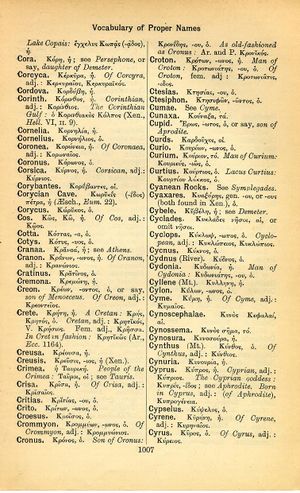Cumae
Λεύσσετε, Θήβης οἱ κοιρανίδαι τὴν βασιλειδᾶν μούνην λοιπήν, οἷα πρὸς οἵων ἀνδρῶν πάσχω → See, you leaders of Thebes, what sorts of things I, its last princess, suffer at the hands of such men
English > Greek (Woodhouse)
See Cyme.
Latin > English (Lewis & Short)
Cūmae: ārum (Cȳmē, Stat. S. 4, 3, 65;
I gen. Cymes, Sil. 13, 494), f., = Κύμη, an ancient colony of the Chalcidians, in Campania, on the sea-coast, renowned on account of its Sibyl, Mel. 2, 4, 9; Plin. 3, 5, 9, § 61; Lucr. 6, 748; Cic. Div. 1, 43, 98; id. Tusc. 3, 12, 27; Verg. A. 6, 2; Hor. Ep. 1, 15, 11; Ov. M. 14, 104; Vell. 1, 4, 1; Cael. ap. Cic. Fam. 8, 1, 2; Juv. 3, 2 et saep.— Hence,
II Cūmānus, a, um, adj., of Cumæ, Cumæan.
1 Adj.: ager, Cic. Agr. 2, 25, 66: litora, Tac. A. 15, 46: linum, Plin. 19, 1, 2, §§ 10 and 11: caementum, id. 35, 13, 47, § 166: calices, made in Cumæ, Varr. ap. Non. p. 146, 11; cf.: fictaque Cumanā lubrica terra rotā, i. e. Cumæan vessels, Tib. 2, 3, 48: orbe patinae tortae, Stat. S. 4, 9, 43: pulvere rubicunda testa, Mart. 14, 114: Apollo, i. e. who was worshipped at Cumæ, Flor. 2, 8, 3; cf. Cic. Div. 1, 43, 98: vates, i. e. the Sibyl, Luc. 5, 183.—
2 Subst.
a Cūmāni, ōrum, m., the inhabitants of Cumæ, Liv. 40, 42, 13.—
b Cūmānum, i, n.
(a) The Cumæan region: in Cumano, Plin. 17, 25, 38, § 243.—
(b) An estate of Cicero near Cumæ, Cic. Fam. 4, 2, 1; id. Att. 4, 10, 2; 14, 10, 3; id. Ac. 1, 1, 1.—*
c Cūmāna, ae, f., a vessel made of Cumæan clay, Apic. 4, 2; 6, 9.—
B Cūmaeus, a, um, adj., Cumæan (poet.): urbs, Verg. A. 3, 441: antrum, Sil. 13, 498: Sibylla, Verg. A. 6, 98; Ov. M. 15, 712; cf. of the same: virgo, id. ib. 14, 135: dux (sc. Aeneae), id. ib. 14, 121: vates, Val. Fl. 1, 5: carmen, i. e. of the Sibyl, Verg. E. 4, 4: in annos Cumaeos vivant, i. e. very long (as the Sibyl was called longaeva sacerdos, Verg. A. 6, 321), Ov. P. 2, 8, 41; cf. Prop. 2, 2, 16.

